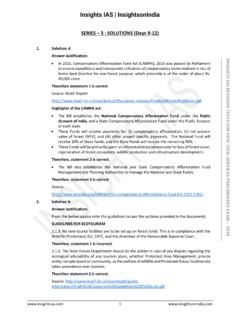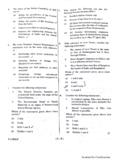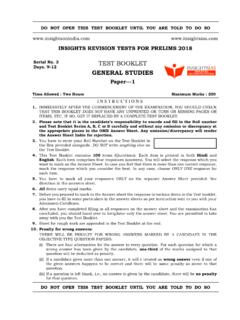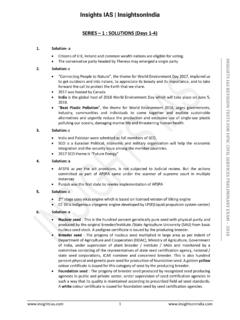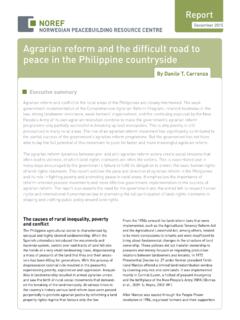Transcription of Indian Agriculture : UNIT 3 LAND REFORMS DURING 1947-70
1 Indian Agriculture : Institutional Perspectives UNIT 3 land REFORMS DURING 1947-70 . Structure Objectives Introduction Need for land REFORMS land REFORMS Measures Abolition of Intermediaries Tenancy REFORMS Ceilings on land Holdings Bhoodan and Gramdan Protection of Tribal land Consolidation of Holdings Choice of Appropriate Form of Farm Organisation Changes in Agrarian Structure Pattern of Landholdings Pattern of Ownership Holdings Pattern of Operational Holdings Let Us Sum UP. Key Words Some Useful Books Answers/Hints to Check Your progress Exercises OBJECTIVES. After going through this unit, you will be in a position to: explain the need for agrarian REFORMS ;. explain the land reform measures undertaken DURING 1950s and 1960s; and assess the impact of REFORMS in changing the unequal and exploitative agrarian structure. INTRODUCTION. In the previous two Units we discussed the agrarian structure prevalent before Independence, particularly DURING the Mughal and British periods.
2 The main characteristics of the agrarian structure which independent India inherited were a) absentee land ownership;. b) exploitation of tenants through high rents and insecurity of tenure ;. c) unequal distribution of land ;. d) tiny and fragmented holdings; and e) lack of adequate institutional finance to Agriculture . On this agrarian structure was imposed a situation in which bulk of the cultivators were short of fixed as well as working capital. This resulted in low investments and thereby low yields in Agriculture . Agrarian structure, as you know, is a broad concept comprising land tenure system as well as credit, marketing, etc. Thus agrarian REFORMS would imply corrective measures in land tenure system, credit and marketing. On the other hand, the concept land REFORMS ' is somewhat narrower than the above and relates to the corrective 32. measures in prevalent land tenure system.
3 Credit and marketing are quite important for agricultural development. However, we will take up these two issues later in Block 5. In this Unit, and the next one, we will consider the land REFORMS measures undertaken after Independence. In the present Unit we will discuss the measures taken DURING 1947-70 while the REFORMS measures after 1970 will be taken up in Unit 4. NEED FOR land REFORMS . As we noticed above, land ownership was highly unequal at the time of Independence. There was a parasitic class of intermediaries who played no role in production. On the other hand, the vast majority of actual cultivators were either tenants or sub- tenants, without any security of tenure . According to the National Commission on Agriculture (1976), this was the root cause of the state of chronic crisis in which Indian agricultural economy was enmeshed before the attainment of Independence. Before Independence, there were three major systems of land tenure , namely Zamindari System, Mahalwari System and Ryotwari System.
4 The Zamindari system was introduced by Lord Cornwalis in 1793 through permanent settlement that fixed the land rights of zamindars in perpetuity without any provision for fixed rents or occupancy rights for actual cultivators. Under the permanent settlement, zamindars were found to be more interested in higher rent than in agricultural improvement. DURING the early nineteenth century, efforts were made to undo the adverse effects of permanent settlement and to provide for temporary settlement as a matter of policy. Regulation VII of 1822 Act provided for temporary settlement with provision for periodic settlement in parts of the United Provinces. In the provinces of Madras and Bombay, ryotwari system was prevalent. Each ryot was recognised by law as the proprietor with the right to transfer or mortgage or sub-let his land . Moreover, in parts of United Provinces and Punjab, Regulation VII of 1822 Act and Regulation IX of 1833 Act provided for Mahalwari Settlement with the entire village community.
5 This required each peasant of the village to contribute to total revenue demand of the village on the basis of the size of holding. In 1885, the Bengal Tenancy Act was passed with a view to conferring occupancy rights upon ryots who were in continuous possession of land for 12 years. The tenant could not be evicted by the landlord, except by a decree of court. Similarly, the Bihar Tenancy Act of 1885 and Orissa Tenancy Act of 1914. granted occupancy rights to tenants. Besides, the Madras Tenancy Act of 1908. provided for protection of ryots from eviction as long as they paid the rents. Nevertheless, since majority of actual cultivators were unrecorded tenants-at-will, these legal measures could not bring much relief to the tiller of the soil. Although the adverse effect of landlordism on agricultural production was most profound in the states of Uttar Pradesh, Bihar, West Bengal and Orissa, other states that were under Ryotwari and Mahalwari Systems also witnessed the growth of a large number of intermediaries with all its adverse impact.
6 The leased-in area constituted nearly 35. per cent of the total operated area in 1950-51. Most of the leases were unwritten and tenants did not have legal security of tenure . The rents varied from 50 per cent to 70 per cent of gross produce. In addition, tenants were often asked to provide free labour to landlords. After Independence therefore, it became necessary to undertake some land REFORMS measures for removing the feudal character of the agrarian economy and paving the way for rapid agricultural growth with social justice. Broadly speaking, the objectives of agrarian REFORMS are as follows: i) To change the unequal and unproductive agrarian structure;. ii) To remove exploitative agrarian relations, often known as patron-client relationship in Agriculture , iii) To promote Agriculture growth with social justice. 33. Indian Agriculture : Check Your Progress 1. Institutional Perspectives 1) How do you define agrarian REFORMS ?
7 2) What were the main objectives of land REFORMS in India? .. 3) Why was it necessary to change the pre-independence agrarian structure? .. land REFORMS MEASURES. After Independence, the Indian National Congress appointed the Agrarian REFORMS Committee under the Chairmanship of Kumarapppa, for making an in-depth study of the agrarian relations prevailing in the country. The committee submitted its report in 1949 which had a considerable impact on the evolution of agrarian REFORMS policy in the post-independence period. The committee recommended that all intermediaries between the state and the tiller should be eliminated and the land must belong to the tiller subject to certain conditions. Let us now examine the various agrarian reform measures undertaken after independence. As already mentioned, the term land REFORMS ' refers to REFORMS undertaken in the land tenure system. The steps include (i) abolition of intermediaries, (ii) fixation of ceilings on land holdings and (iii) redistribution of surplus land among landless or semi-landless peasants.
8 Besides, any special measures adopted to prevent alienation of tribal land and consolidate fragmented holdings come within the broad definition of agrarian REFORMS . 34. Abolition of Intermediaries Following the recommendation of Kumarappa Committee, all the states in India enacted legislation for the abolition of intermediary tenures in the 1950s, although the nature and effects of such legislation varied from state to state. In West Bengal and Jammu & Kashmir, legislation for abolishing intermediary tenures was accompanied by simultaneous imposition of ceilings on land holdings. In other states, intermediaries were allowed to retain possession of lands under their personal cultivation without limit being set, as the ceiling laws were passed only in the1960s. As a result, there was enough time left for the intermediaries to make legal or illegal transfers of land . Besides, in some states, the law applied only to tenant interests like sairati mahals etc.
9 And not to agricultural holdings. Therefore, many large intermediaries continued to exist even after formal abolition of zamindari. Nevertheless, it has been estimated that consequent upon the legal abolition of intermediaries between 1950 and 1960, nearly 20 million cultivators in the country were brought into direct contact with the Government. Tenancy REFORMS The Agrarian REFORMS Committee recommended against any system of cultivation by tenants and maintained that leasing of land should be prohibited except in the case of widows, minors and disabled persons. This viewpoint received further strength subsequently in various Five Year Plans. According to the Second Five Year Plan, abolition of intermediary tenures and bringing the tenants into direct relations with the state would give the tiller of the soil his rightful place in the agrarian system and provide him with full incentives for increasing agricultural production.
10 Immediately after Independence, although the major emphasis was on the abolition of intermediaries, certain amendments to the existing tenancy laws were made with a view to providing security to the tenants of ex-intermediaries. But these legal measures provoked the landlords to secure mass eviction of tenants, sub-tenants and share- croppers through various legal and extra-legal devices. The highly defective land records, the prevalence of oral leases, absence of rent receipts, non-recognition in law of share- croppers as tenants and various punitive provisions of the tenancy laws were utilized by the landlords to secure eviction of all types of tenants. To counteract such a tendency, therefore, it became necessary on the part of the State Governments to enact or amend the laws in the subsequent years and provide for adequate safeguards against illegal eviction and ensure security of tenure for the tenants-at-will.




